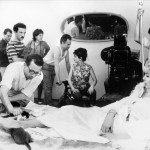Dir. by Agnès Varda
Images: Constant movement, both of the camera and of objects and people within the frame (for instance, the rocking chair and swing in Cleo’s otherwise minimalist apartment). Jump cuts, though not used so frequently as in Godard. Long, overhead shots of Cleo as she wanders through the park (think Antoine and his classmates in 400 Blows). And, perhaps most importantly, the stares of passer-bys on Paris streets. As the camera assumes Cleo’s subjective perception, we, the audience, feel the eyes of men on us.
• • •
Cleo (Corrinne Marchand) is a beautiful, spoiled, self-obsessed pop singer. As the film opens, she is having her fortune told by a tarot reader, who is startled to discover death and cancer in the singer’s immediate future. Cleo is quite upset, as she is waiting to meet with a doctor to discuss the results of a medical examination. The remainder of the 90 minute film chronicles Cleo’s afternoon, from the time that she leaves the tarot reader until her appointment at the hospital two hours later. We see her return home to her fashionably minimalist apartment, where she tends her kittens, does her exercises, and meets with her songwriters. Exasperated by the jokes of her friends and by her own worries, she sets off alone through the streets, cafes, and parks of Paris, running errands with a friend and meeting a young soldier, Antoine, who is to ship off for the battlefields of Algeria on the following morning.
Cléo de 5 à 7 is very much a film about perception — about looking and being looked at, and the warped sensibilities formed when worth is based solely on appearances. In that sense, it also seems to be very much a woman’s film (and one ripe for the Laura Mulvey treatment). This is most obvious in several scenes when Cleo is walking through crowded streets. Vardas cuts constantly to Cleo’s POV, using documentary-like footage of faces turning their eyes toward the camera. As a male viewer raised on the voyeuristic thrills of male filmmakers, it’s a disconcerting experience — feeling all of those eyes on me. The implication is that such an existence has disfigured Cleo’s self-image and stunted her emotional development. Vardas contrasts Cleo’s superficiality with the level-headed confidence of her friend Dorothee, a nude model who finds joy and satisfaction in her body, but not pride.
The end of Cléo de 5 à 7 has some very effective moments, but suffers from a too tidy conclusion. While walking through a park, Cleo meets Antoine, a soldier who puts a human face on the war in Algiers, a conflict that is acknowledged throughout the film through radio reportsand overheard conversations. My favorite moment occurs when he accompanies Cleo to her scheduled appointment. As they ride a trolley across town, Antoine pulls a flower from a passing truck and places it in Cleo’s hair. Vardas lingers on the image, allowing 20 or 30 seconds of silence between the actors, their two faces framed tightly in close-up. There’s an awkward (but very charming) embarrassment between them. It’s a great example of what the New Wave directors have done best: capturing honest and instantly identifiable images. I think I would find the film more satisfying had it ended there. But in the final scenes, when Cleo learns that she is ill but will recover with a few months’ treatment, Vardas too neatly resolves a plot that is secondary to the film’s larger concern. My frustration is that Cleo, a woman whose worth has been formed by the opinions of the men around her, seems to have only found redemption through Antoine, another man. Perhaps a minor quibble, but one that leaves me less than satisfied.
